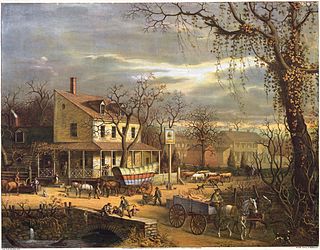
The Cott Inn is a medieval inn at Dartington, Devon, in the southwest of England. Founded in 1307, it is the second oldest inn in Britain, and a listed building.

The Cott Inn is a medieval inn at Dartington, Devon, in the southwest of England. Founded in 1307, it is the second oldest inn in Britain, and a listed building.
The Cott Inn was founded in 1307 while the Fitz Martin family held the manor of Dartington, [1] making it the second-oldest inn in Britain. [2] It is named for the merchant Johannes Cott, like the local hamlet of Cott. The inn served travellers, including those carrying wool or tin, on the packhorse road between Ashburton and Totnes. [1]
The inn's medieval walls are made of stone rubble and "perhaps some cob" [3] (subsoil mixed with straw), rendered and painted white. It has a thatched roof, supposedly the longest such roof in Britain. Thick closely-spaced rough-hewn wooden cross-beams support the low ceilings. The rooms have inglenook fireplaces. [4] [2] Its original plan was of three rooms with a through passage, with chimney-stacks in the gables at both ends; if there was an open central hall, it has left no trace. The room at the higher end has a stone newel staircase beside the chimney-stack. The building was remodelled, probably late in the 17th century, and extended in the 18th century. The upper windows are 19th or 20th century; some of them break the line of eaves with "eyebrows in the thatch". The lower windows are older 4-lights. The roof is supported on "principals" (timbers) with "straight feet" bedded into the tops of the front and back walls. [3]
It is a Grade II listed building; it was added to the list in 1952. [3]

Gemma Bowes and colleagues in The Guardian described it as "a homely family-run pub...a cosy choice for winter, and with live music in the bar on Wednesday and Sunday nights the atmosphere can be crackling." They described the five bedrooms as "bright, modern, and comfortable". [5] Anna Turns, reviewing the inn for The Daily Telegraph , wrote that the rooms had "much more personality than any run-of-the-mill chain-pub accommodation", while the made-to-order dishes were "not speedy pub grub but worth the wait". [2] In her view, "this charming historic Devonshire gastropub has a great seasonal menu, heaps of character and a lively and welcoming atmosphere." [2] Patrick McCaig, reviewing the inn for DevonLife, calls it friendly and well run. [4] Visit Totnes calls it a "stunning 14th century thatched pub ... with cosy log fires" for the winter and a "large pretty garden" and delicious food from the "alfresco kitchen" for the summer. [6] Lonely Planet states that "The 14th-century Cott is pretty much the perfect English inn: rambling, thatched and lined with beams." [7]
In 2016, the Cott Inn was 8th in The Daily Telegraph's list of "30 Best Pubs in Britain". [4]
In 2019, it was named "Great British Pub of the Year". [8]
Also in 2019, The Guardian listed the Cott Inn among its "40 great cosy hotels, B&Bs and pubs with rooms for winter". [5]

Inns are generally establishments or buildings where travelers can seek lodging, and usually, food and drink. Inns are typically located in the country or along a highway. Before the advent of motorized transportation, they also provided accommodation for horses.

Totnes is a market town and civil parish at the head of the estuary of the River Dart in Devon, England, within the South Devon Area of Outstanding Natural Beauty. It is about 5 miles (8.0 km) west of Paignton, about 7 miles (11 km) west-southwest of Torquay and about 20 miles (32 km) east-northeast of Plymouth. It is the administrative centre of the South Hams District Council.

Great Torrington is a market town in Devon, England. Parts of it are sited on high ground with steep drops down to the River Torridge below, with the lower-lying parts of the town prone to occasional flooding. Torrington is in the centre of Tarka Country, a landscape captured by Henry Williamson in his novel Tarka the Otter in 1927. Great Torrington has one of the most active volunteering communities in the United Kingdom.

Dartington Hall in Dartington, near Totnes, Devon, England, is an historic house and country estate of 1,200 acres (4.9 km2) dating from medieval times. The group of late 14th century buildings are Grade I listed; described in Pevsner's Buildings of England as "one of the most spectacular surviving domestic buildings of late Medieval England", along with Haddon Hall and Wingfield Manor. The medieval buildings are grouped around a huge courtyard; the largest built for a private residence before the 16th Century, and the Great Hall itself is the finest of its date in England. The west range of the courtyard is regarded nationally as one of the most notable examples of a range of medieval lodgings. The medieval buildings were restored from 1926 to 1938.

The White Hart was the personal badge of Richard II, who probably derived it from the arms of his mother, Joan "The Fair Maid of Kent", heiress of Edmund of Woodstock. It may also have been a pun on his name, as in "Rich-hart". In the Wilton Diptych, which is the earliest authentic contemporary portrait of an English king, Richard II wears a gold and enamelled white hart jewel, and even the angels surrounding the Virgin Mary all wear white hart badges. In English Folklore, the white hart is associated with Herne the Hunter.

Totnes is a parliamentary constituency in Devon represented in the House of Commons of the UK Parliament since December 2019 by Anthony Mangnall, a Conservative. Mangnall defeated incumbent Sarah Wollaston who had originally been elected as a Conservative but defected to the Liberal Democrats earlier that year.

Totnes railway station serves the towns of Totnes and Dartington in Devon, England. It was opened by the South Devon Railway Company in 1847. Situated on the Exeter to Plymouth Line, it is 222 miles 66 chains measured from the zero point at London Paddington via Box.

Lustleigh is a small village and civil parish in the Wray Valley, inside the Dartmoor National Park in Devon, England. It is between the towns of Bovey Tracey and Moretonhampstead. The village has often been named amongst the best or prettiest villages in the country in various publications, particularly due to the traditional thatched buildings in the village centre, and local activities such as the Lustleigh Show. This has also led to it being noted as the most expensive rural location to buy a house.

The Tan Hill Inn is a public house at Tan Hill, North Yorkshire. It is the highest inn in the British Isles at 1,732 feet (528 m) above sea level. According to the Guinness Book of World Records, it is slightly higher than the Cat and Fiddle Inn in the Peak District, which is at 1,690 feet (520 m).
The Silkie were an English folk music group. Their name was derived from an Orcadian song "The Great Silkie of Sule Skerry", which they sometimes performed. They were briefly considered to be the English equivalent of Peter, Paul and Mary, with their common repertoire of Bob Dylan songs, and the original Australian folk group, The Seekers.
Maurice Anthony Ash was an environmentalist, writer, farmer, and planner. He was chairman of the Town and Country Planning Association and of the Dartington Trust.

Cheriton Bishop is a village and civil parish situated on the northern borders of Dartmoor National park between Exeter and Okehampton, in Devon, England. The population at the 2011 Census was 652. The history of the settlement can be traced back over a thousand years when the old village centre was established as a commercial centre for the local farming community.

The Fountain Inn is a 16th-century public house in the village of Ashurst, in the Horsham district of West Sussex, England. After a period as a farmhouse, it was converted into the village inn and was extended and given a Georgian façade in the 18th century. English Heritage has listed the building at Grade II for its architectural and historical importance.

The Fisherman's Cot is an inn on the A3072 road to the northwest of Bickleigh near Tiverton, in northeastern Devon. It is operated by Marston's Inns and lies on the River Exe.
Milton Damerel is a village, parish and former manor in north Devon, England. Situated in the political division of Torridge, on the river Waldon, it covers 7 square miles (18 km2). It contains many tiny hamlets including Whitebeare, Strawberry Bank, East Wonford and West Wonford. The parish has a population of about 450. The village is situated about 5 miles (8.0 km) from Holsworthy, 13.081 miles (21.052 km) from Bideford and 22.642 miles (36.439 km) from Barnstaple. The A388 is the main road through the parish.

The Blue Anchor Inn is a Grade II* listed inn in Aberthaw, Vale of Glamorgan, south Wales.

The Bush Inn is a Grade II listed public house in St Hilary, near Cowbridge, Vale of Glamorgan, south Wales. The current inn dates to the 16th century. It has a thatched roof, thick stone walls, low oak beams, flagstone floors, old pews, a stone spiral staircase, and an inglenook fireplace. The benches outside the pub look across to the Church of St Hilary.

The Cove House Inn is an 18th-century public house on the Isle of Portland, Dorset, England. It is situated within the village of Chiswell, and alongside Chesil Beach on the esplanade. The Cove House Inn remains one of Portland's most popular pubs, and has been reputed to be one of the best inns for panoramic views in the area. The pub has been a Grade II Listed Building since May 1993.

The Drewe Arms is a Grade II* listed public house on the north side of The Square in Drewsteignton, Devon.

The Luppitt Inn is the only public house at Luppitt, Devon. Located in the front rooms of a farmhouse, the building is constructed from stone, rendered on one side and includes a tiled roof. The main house, still part of a working farm, was built in the early 19th century. The pub entrance is on the north side of the house, leading to a two-roomed pub. The serving room includes a simple counter made of matchboard, and some simple shelves, as well as a few seats, whilst the second room includes a brick fireplace. The toilets are outside, across the yard. The only table in the pub is covered in puzzles. The unique layout has meant that the pub is on the Campaign for Real Ale's National Inventory of Historic Pub Interiors.